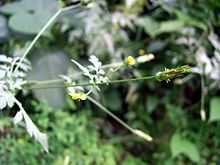Bidens pilosa
| Bidens pilosa | |
|---|---|
 | |
| Scientific classification | |
| Kingdom: | Plantae |
| (unranked): | Angiosperms |
| (unranked): | Eudicots |
| (unranked): | Asterids |
| Order: | Asterales |
| Family: | Asteraceae |
| Genus: | Bidens |
| Species: | B. pilosa |
| Binomial name | |
| Bidens pilosa L. | |
Bidens pilosa is a species of flowering plant in the aster family, Asteraceae. It is native to the Americas but it is known widely as an introduced species of other regions, including Asia and the Pacific Islands.[1] Its many common names include beggar-ticks, cobbler's pegs, and Spanish needle.[1]
This plant is considered a weed in some tropical habitats. However, in some parts of the world it is a source of food or medicine.[2] For example, in sub-Saharan Africa, the tender shoots and young leaves are used fresh or dried as a leaf vegetable, particularly in times of scarcity.
Description
Bidens pilosa is an annual forb of gracile habit, growing up to 1.8 meters tall. It grows aggressively on disturbed land and often becomes weedy. The leaves are oppositely arranged and pinnate in form with three to five dentate, ovate-to-lanceolate leaflets. The petioles are slightly winged.
The plant may flower at any time of the year, but in temperate regions it blooms mainly in summer and autumn. Flowers are borne in small heads on relatively long peduncles. The heads bear about four or five broad white ray florets, surrounding many tubular yellow disc florets. The fruits are slightly curved, stiff, rough black rods, tetragonal in cross section, about 1 cm long, with typically two to three stiff, heavily barbed awns at their distal ends. The infructescences form stellate spherical burrs about one to two centimeters in diameter. The barbed awns catch onto animals or clothing, and can injure flesh. It is an effective means of seed dispersal by zoochory, as the seeds are transported by animals. This mechanism has helped the plant become a cosmopolitan weed in temperate and tropical regions.
Common names


This plant has many common names in different regions and languages, including:[1]
- Chinese: gui zhen cao
- English: beggar's tick, beggar-ticks, hairy beggar-ticks, black-jack, broom stick, broom stuff, cobbler's pegs, devil's needles, hairy bidens, Spanish needle, farmers friend
- Fijian: batimadramadra, matakaro, matua kamate, mbatikalawau, mbatimandramandra
- French: bident hérissé, bident poilu, herbe d'aiguille, herbe villebague, piquants noirs
- Hawaiian: kī, nehe, kī nehe, kī pipili
- Japanese: ko-sendangusa
- Mangareva language: tarou, taru
- Māori: koheriki, kohiriki[3]
- Māori (Cook Islands): kamika tuarongo, piripiri, nīroa, piripiri nīroa, piripiri kerekere
- Niuean: kofetoga, kofetonga
- Philippines: pisau-pisau
- Bontoc language: nguad, puriket
- Ivatan language: dadayem
- Pukapukan: pilipili
- Spanish: acetillo, amor seco, arponcito, asta de cabra, cacho de cabra, masquia, mazote, papunga chipaca, pega-pega, perca, sirvulaca
- Tahitian: piripiri
- Tongan: fisi‘uli
- Vietnamese: xuyến chi
- Wallisian: tae puaka
- Kifumbira: Inyabalasanya
Traditional uses
In traditional Chinese medicine, this plant is considered a medicinal herb, called xian feng cao (Chinese: 咸豐草).
In traditional Bafumbira medicine, this plant is applied on a fresh wound and is known to be a medicinal herb, called inyabalasanya
Chemistry
Almost two hundred compounds have been isolated from B. pilosa, especially polyacetylenes and flavonoids.[4] The plant contains the chalcone okanin[5] and ethyl caffeate, a hydroxycinnamic acid.[6]
Extracts of B. pilosa suppressed the growth of isolated adult T-cell leukemia cells in vitro.[7]
See also
| Wikimedia Commons has media related to Bidens pilosa. |
References
- ↑ 1.0 1.1 1.2 Bidens pilosa. Pacific Island Ecosystems at Risk (PIER). USFS.
- ↑ Grubben, G. J. H. & O. A. Denton. (2004) Plant Resources of Tropical Africa 2. Vegetables. PROTA Foundation, Wageningen; Backhuys, Leiden; CTA, Wageningen.
- ↑ "Plant Use Details of Bidens pilosa". Landcare Research. Retrieved November 20, 2012.
- ↑ Silva, F. L., et al. (2011). Compilation of secondary metabolites from Bidens pilosa. Molecules 16(2), 1070-1102.
- ↑ Presence of Compounds in Picao preto (Bidens pilosa). Raintree Nutrition.
- ↑ Chiang, Y., et al. (2005). Ethyl caffeate suppresses NF-κB activation and its downstream inflammatory mediators, iNOS, COX-2, and PGE2 in vitro or in mouse skin. Br J Pharmacol. 146(3) 352–63. PMID 16041399
- ↑ Nakama, S., et al. (2011). .Anti-adult T-cell leukemia effects of Bidens pilosa. International Journal of Oncology 38(4), 1163-73. PMID 21318218
External links
- PROTAbase Record display for Bidens pilosa. Plant Resources of Tropical Africa (PROTA). Retrieved on 12 April 2010.
- "Bidens pilosa". Integrated Taxonomic Information System. Retrieved 12 April 2010.
- Taxonomy browser (Bidens pilosa). National Center for Biotechnology Information. Retrieved on 12 April 2010.